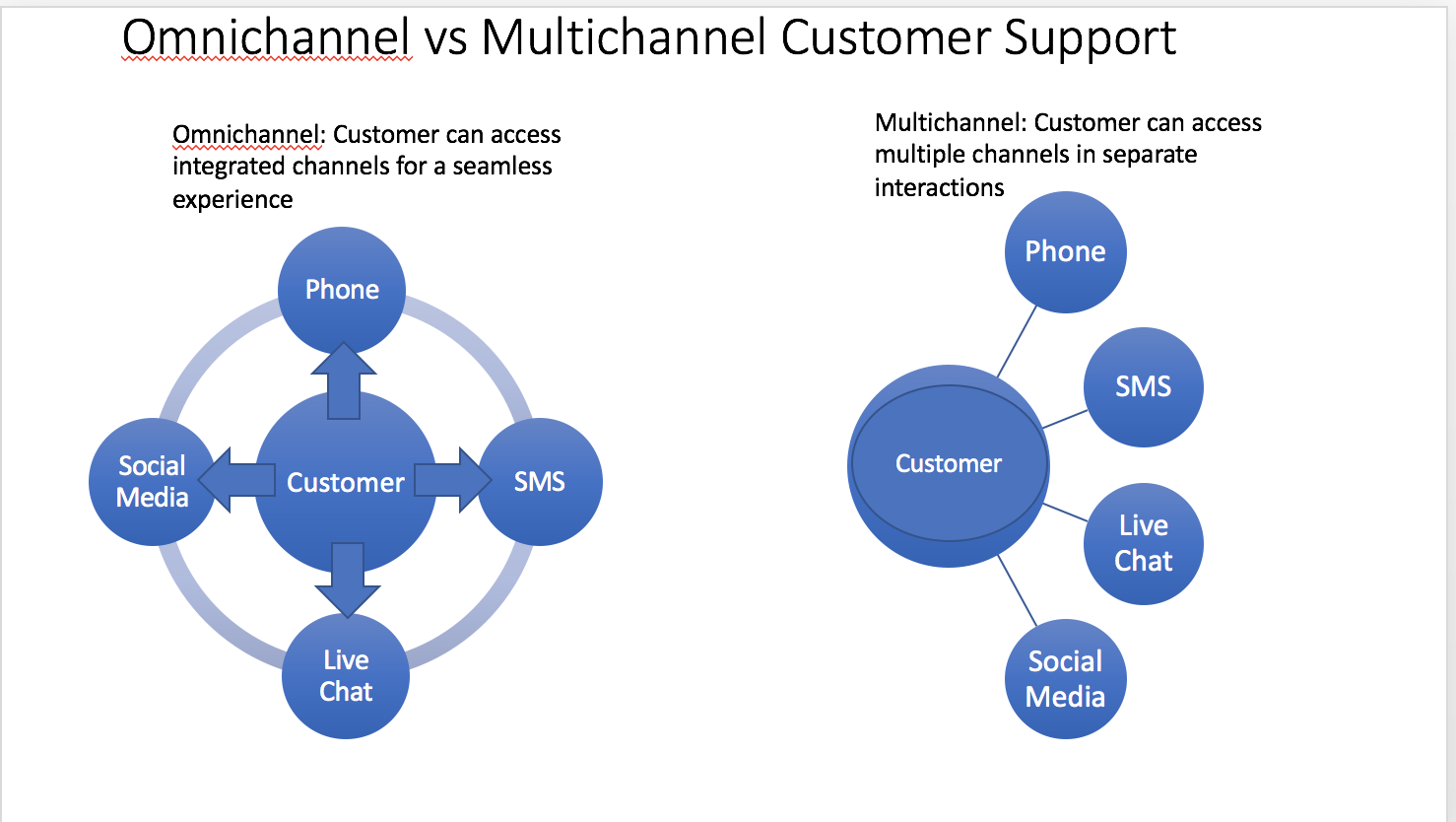
Omnichannel vs Multichannel Customer Support
[Updated January 22, 2022]
In the world of customer support, many brands and businesses like e-commerce and even brick and mortar or offline retail stores offer multiple channels of communication through which customers can communicate.
These channels can include voice, text, live chat, email, website or web page, mobile or mobile app, bot, social media like Facebook and Facebook Messenger and many other tools or devices. The advantage of offering more than one touchpoint of communication is that consumers and end users can communicate via the platform that is preferable to them at any given moment even when they’re miles away. This can be in the form of omnichannel or multichannel support – two similar, yet different, approaches or behavior.
What is Multichannel Support?
By definition, multichannel support is exactly what it sounds like–multiple channels through which a brand or business provides customer service and support.
At any given time, a customer can choose to use whichever method is convenient for them. For example, if a shopper has a simple concern like a product information inquiry, purchasing or shopping issue, mail order request, or promo or discount question, they may choose to communicate via SMS or through the Internet via a live chat service. If their question is more in-depth and difficult to articulate through typing, like download or software problems, web browser and other tech issues, or a financial transaction or pricing dispute, they may choose to call and interact with a call center agent directly to relay more data and content.
Multichannel support delivers convenience to your audience or target market and customers, allowing them to choose the method of communication that benefits and works best for them in different scenarios, often with just a simple click of a link. This approach shows that the company is committed to improve its service and cares about the customer’s preferences and overall user experience.
Omnichannel support takes the customer experience and journey to the next level. This also provides a holistic approach and presents many opportunities in terms of boosting your marketing strategy and advertising, online presence, brand awareness, brand loyalty, metrics, value proposition, and of course, revenue.
This approach focuses on seamless integration and processes of the channels available. Not only can a customer choose the method of communication that is most convenient for initiating an interaction, but they can transition between different methods in the same interaction or engagement.
For example, if a customer is interacting with a sales or customer service agent through live chat but doesn’t feel the issue is being resolved, that same agent can call the customer directly to continue the conversation through a voice phone call. This allows for a more effective resolution in the same interaction. The customer doesn’t have to start over with a new agent or spend time figuring out which method of communication they should try next in order to resolve the issue.
This results in a smooth customer experience, where the customer’s issue is resolved in one seamless interaction, which is synonymous with customer service success. This is crucial if you want to have lifetime customers.
What is Omnichannel Support?
Omnichannel support takes the customer experience and journey to the next level. This also provides a holistic approach and presents many opportunities in terms of boosting your marketing strategy and advertising, online presence, brand awareness, brand loyalty, metrics, value proposition, and of course, revenue.
This approach focuses on seamless integration and processes of the channels available. Not only can a customer choose the method of communication that is most convenient for initiating an interaction, but they can transition between different methods in the same interaction or engagement.
For example, if a customer is interacting with a sales or customer service agent through live chat but doesn’t feel the issue is being resolved, that same agent can call the customer directly to continue the conversation through a voice phone call. This allows for a more effective resolution in the same interaction. The customer doesn’t have to start over with a new agent or spend time figuring out which method of communication they should try next in order to resolve the issue.
This results in a smooth customer experience, where the customer’s issue is resolved in one seamless interaction, which is synonymous with customer service success. This is crucial if you want to have lifetime customers.
Omnichannel Customer Service

Omnichannel vs Multichannel Support: Which is the Best Approach?
From the perspective of the customer, well-executed omnichannel support will result in a smoother overall experience. Learn a couple of reasons why:
- Consistency: In multichannel, there is a tendency for channels to become siloed, possibly leading to a different and separate experience for the customer in each channel. Even if those channels aren’t utilized in the same interaction, the customer will notice a difference in processes, implementation and experience over time. Omnichannel focuses on consistency across channels, so that no matter when or which channel, the customer experience will always be of the same caliber.
- Ease: While multichannel offers different options for the customer to choose from, it doesn’t always make it easy for the customer to interact. If one channel isn’t working for a customer, it’s up to the customer to start a new interaction and get a word or an update from an agent in a new channel, which can be frustrating and confusing. Omnichannel makes these choices and transitions easy for a customer to make, without them having to think about it. Customers don’t want to think about channels; they just want an easy and customized interaction that solves their issues quickly.
From the perspective of the brand or business, omnichannel is a significant investment. Not only does it require highly integrated and advanced technology, but true omnichannel customer service requires every employee to operate from the mindset of delivering and sharing a seamless and consistent customer experience.
Digital Channels cannot work in silos. Agents must be agile enough to toggle between channels without causing an interruption in the customer interaction. Each channel, although unique in the communication method, must provide and target a consistent experience for the customer, every time.
Multichannel vs Omnichannel Support- Which is the Best Approach?
Ultimately, deciding between omnichannel vs multichannel customer support depends on the complexity of your business and the level of quality you are striving to achieve when it comes to customer insight and customer support.
The ultimate goal, no matter which strategy you choose, is for customers to never have to think about “channels” at all. Are your customers getting what they need, when they need it, through seamless interactions? If not, omnichannel support may be the stronger and worthy solution.